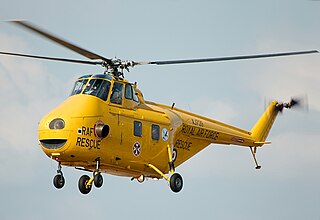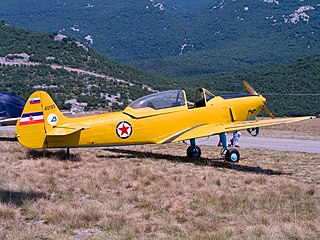Soko was a Yugoslav aircraft manufacturer based in Mostar, SR Bosnia and Herzegovina. The company was responsible for the production of many military aircraft for the Yugoslav Air Force.

The Aermacchi or Macchi MB-326 is a light military jet trainer designed and produced by the Italian aircraft manufacter Aermacchi. It is one of the most commercially successful aircraft of its type, being bought by more than 10 countries and produced under licence in Australia, Brazil and South Africa.

The Westland Whirlwind helicopter was a British licence-built version of the U.S. Sikorsky S-55/H-19 Chickasaw. It primarily served with the Royal Navy's Fleet Air Arm in anti-submarine and search and rescue roles. It was also exported to other countries, and the Whirlwind was succeeded by the turbine powered Westland Wessex which was developed from the H-19/Whirlwind. The helicopter was made in many variants using a variety of radial (piston) and turbine engines.

The de Havilland Canada DHC-4 Caribou is a Canadian specialized cargo aircraft with short takeoff and landing (STOL) capability. The Caribou was first flown in 1958 and although mainly retired from military operations, is still in use in small numbers as a rugged bush airplane.

The Sikorsky H-19 Chickasaw is a multi-purpose piston-engined helicopter that was used by the United States Army and United States Air Force. It was also license-built by Westland Aircraft as the Westland Whirlwind in the United Kingdom. United States Navy and United States Coast Guard models were designated HO4S, while those of the U.S. Marine Corps were designated HRS. In 1962, the U.S. Navy, U.S. Coast Guard and U.S. Marine Corps versions were all redesignated as H-19s like their U.S. Army and U.S. Air Force counterparts.

The Vultee BT-13 Valiant is an American World War II-era basic trainer aircraft built by Vultee Aircraft for the United States Army Air Corps, and later US Army Air Forces. A subsequent variant of the BT-13 in USAAC/USAAF service was known as the BT-15 Valiant, while an identical version for the US Navy was known as the SNV and was used to train naval aviators for the US Navy and its sister services, the US Marine Corps and US Coast Guard.

The Avro Canada CF-100 Canuck is a Canadian twinjet interceptor/fighter designed and produced by aircraft manufacturer Avro Canada. It has the distinction of being the only Canadian-designed fighter to enter mass production.

The UTVA Aero 3 was a piston-engined military trainer aircraft built in Yugoslavia to replace the Ikarus Aero 2 then in service. One hundred ten were built, in Yugoslav Air Force service from 1958 to mid-1970s. It was superseded by the UTVA 75.

The Soko J-22 Orao is a Yugoslavian/Serbian twin-engined, subsonic ground-attack and aerial reconnaissance aircraft. It was developed and built in collaboration by SOKO in Yugoslavia and by Avioane Craiova in neighbouring Romania, being known in the latter as the IAR-93 Vultur.

The Fairchild C-119 Flying Boxcar is an American military transport aircraft developed from the World War II-era Fairchild C-82 Packet, designed to carry cargo, personnel, litter patients, and mechanized equipment, and to drop cargo and troops by parachute. The first C-119 made its initial flight in November 1947, and by the time production ceased in 1955, more than 1,100 had been built.

The Avioane Craiova IAR-93 Vultur (Eagle) is a twinjet, subsonic, close support, ground attack and tactical reconnaissance aircraft with secondary capability as low level interceptor. Built as single-seat main attack version or combat capable two-seat version for advanced flying and weapon training, it was developed in 1970s by Romania and Yugoslavia to become more independent from Soviet equipment. The Romanian aircraft were built by I.R.Av. Craiova as IAR-93, and its Yugoslav counterpart by Soko as the Soko J-22 Orao. For Romania, the IAR-93 was intended to replace MiG-15s and MiG-17s in the fighter-bomber role.

The Sikorsky H-34 is an American piston-engined military utility helicopter originally designed by Sikorsky as an anti-submarine warfare (ASW) aircraft for the United States Navy. A development of the smaller Sikorsky H-19 Chickasaw (S-55), the H-34 was originally powered by a radial engine, but was later adapted to turbine power by the British licensee as the Westland Wessex and by Sikorsky as the S-58T. The H-34 was also produced under license in France by Sud Aviation.

The Soko G-2 Galeb is a Yugoslav single engine, two-seater jet trainer and light ground-attack aircraft. The G-2 was developed during the 1950s by the Aeronautical Technical Institute at Žarkovo as a replacement for the Lockheed T-33 in service with the Yugoslav Air Force. Production started in 1965 at the Soko aircraft factory in Mostar, and ended in 1985 with 248 aircraft delivered. The G-2 had the distinction of being the first mass-produced jet aircraft in socialist Yugoslavia. It also served as a basis for the single-seat ground-attack J-21 Jastreb.

The de Havilland DH.104 Dove is a British short-haul airliner developed and manufactured by de Havilland. The design, which was a monoplane successor to the pre-war Dragon Rapide biplane, came about from the Brabazon Committee report which, amongst other aircraft types, called for a British-designed short-haul feeder for airlines.

The Westland WS-51 Dragonfly helicopter was built by Westland Aircraft and was an Anglicised licence-built version of the American Sikorsky S-51.

The Percival Proctor is a British radio trainer and communications aircraft of the Second World War. The Proctor is a single-engined, low-wing monoplane with seating for three or four, depending on the model.
The 105th Fighter-Bomber Aviation Regiment was an aviation regiment established in 1946 as 3rd Training Aviation Regiment as part of the Yugoslav Air Force.
The 461st Light Combat Aviation Squadron was an aviation squadron of Yugoslav Air Force formed in 1953 at Niš airfield as Training Squadron of 29th Aviation Division.
The 245th Fighter-Bomber Aviation Squadron was an aviation squadron of Yugoslav Air Force formed in 1953 at Batajnica airfield as Training Squadron of 44th Aviation Division.
The 465th Light Combat Aviation Squadron was an aviation squadron of Yugoslav Air Force formed in April 1961 at Mostar airfield as part of 105th Training Aviation Regiment. It has moved to Zadar military airport Zemunik later same year.
















